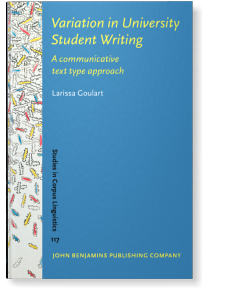Variation in University Student Writing
A communicative text type approach
This book provides a comprehensive description of the situational and linguistic characteristics of undergraduate student writing, considering both assignment type and discipline. Drawing on a corpus of more than 900 undergraduate student assignments from four disciplinary groups (Arts and Humanities, Social Sciences, Physical Sciences, and Life Sciences), the book combines corpus-based analyses of linguistic features with analyses of communicative purposes and text characteristics. Variation in University Writing takes a new approach to register variation by grouping assignments by their communicative purpose (to argue, to explain, to compare, to describe, to narrate a personal event, to give a procedural recount, to give personal advice, and to propose), rather than register categories. A multidimensional analysis provides a detailed description of the linguistic patterns of undergraduate writing. The findings presented in this book will be of interest to teachers of writing, instructors of English for Academic Purposes (EAP), and researchers of university writing.
[Studies in Corpus Linguistics, 117] 2024. xviii, 239 pp.
Publishing status:
© John Benjamins
Table of Contents
-
List of figures | pp. xi–xiv
-
List of tables | pp. xv–xviii
-
Chapter 1. Introduction | pp. 1–33
-
Chapter 2. Corpus and data analysis | pp. 34–44
-
Chapter 3. The challenges of classifying university writing into register categories | pp. 45–65
-
Chapter 4. The communicative text types of university writing | pp. 66–91
-
Chapter 5. Textual characteristics of university communicative text types | pp. 92–113
-
Chapter 6. A multidimensional analysis of university communicative text types | pp. 114–151
-
Chapter 7. What is an essay? Comparing the communicative text type and the register approach | pp. 152–185
-
Chapter 8. Conclusion and implications | pp. 186–208
-
References | pp. 209–213
-
Appendixes
-
Appendix A. Reliability of automatic tags given by the Biber Tagger on texts written by L1-English and L2-English students | pp. 216–218
-
Appendix B. Tag-fixing script | p. 219
-
Appendix C. All combinations of purposes in the corpus | p. 220
-
Appendix D. Overall features selected for factor analysis | pp. 221–223
-
Appendix E. Full factorial structure matric for the three-factor solution | pp. 224–225
-
Appendix F. Correlation and scree plot | pp. 226–227
-
Appendix G. Mean and standard deviation for each factor | p. 228
-
Appendix H. Simple effects Dimensions 1–3 | pp. 229–237
-
Index | p. 239
Subjects
Communication Studies
Main BIC Subject
CFG: Semantics, Pragmatics, Discourse Analysis
Main BISAC Subject
LAN009030: LANGUAGE ARTS & DISCIPLINES / Linguistics / Pragmatics
